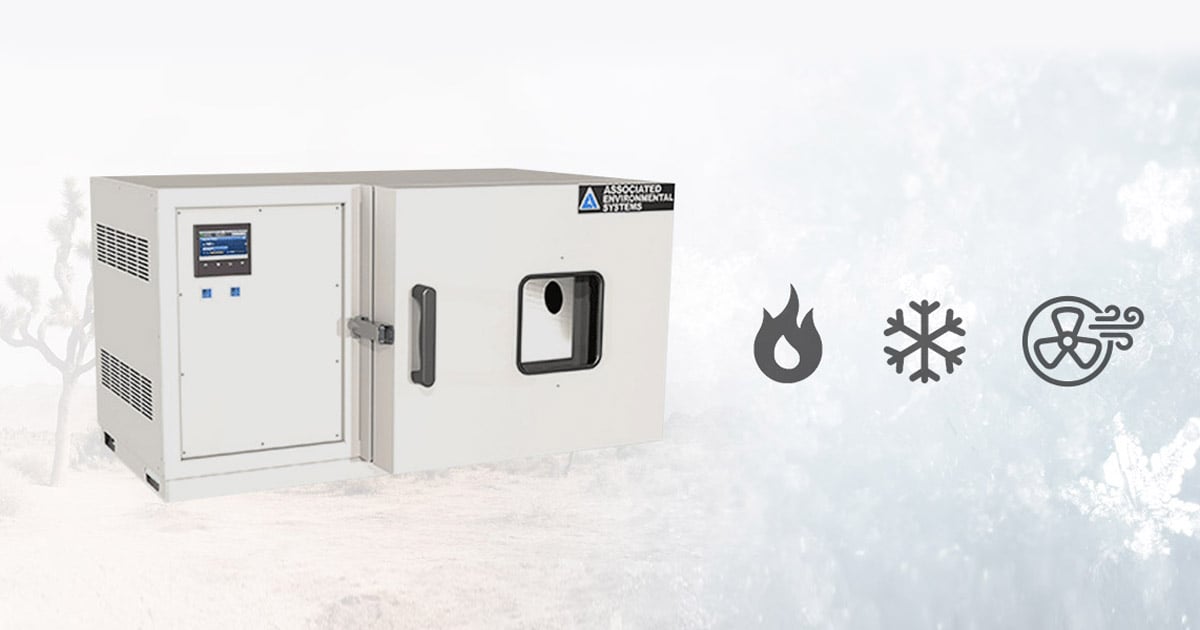Which Temperature Chamber Is Best for Temperature Cycling?

Do you ever wonder how many tests your electronics and electrical components, such as batteries, navigation systems, vehicles, medical devices, semiconductors, and airplanes, went through? Usually, industries place products through a series of tests to ensure safety and performance before being brought to market. One of these tests is temperature cycling.
Temperature Test Chambers
As an environmental chamber manufacturer with over sixty years of experience, Associated Environmental Systems (AES) designs and builds expert temperature chambers ideal for temperature cycling. Tailored to meet your needs, we offer a variety of chambers with optimal features that will help you accomplish your goals. Learn more about our offerings and how our chambers can give companies the confidence that their products can be the best they can be.
What Is Temperature Cycling?
Alternatively known as thermocycling, temperature cycling subjects products, materials, or components to alternating high and low temperatures to determine their durability and breaking points. By repeating those temperature changes, engineers can analyze how effective DUTs are likely to perform under real-life conditions. It can catch defects, such as breaking, cracking, seal failure, short-circuiting, warpage, and debonding. Mechanical failures caused by thermocycling are sometimes referred to as fatigue failure.
What Is Thermal Shock Testing?
Temperature cycling is similar to thermal shock testing. The only primary differentiator is how rapid temperature changes occur during testing. Thermal shock testing immediately exposes devices to opposite, extreme temperatures, while temperature cycling is more gradual. In cycling, a DUT may soak in a test chamber for hours at a specific temperature before swiftly dropping to another lower temperature level. Then it’s ramped up again–cycle and repeat. Ideally, to reach even greater extremes, you can utilize a thermal shock chamber to achieve polar opposite temperatures within one chamber. The chamber is designed with two zones, with the product pneumatically lifting your DUT from one extreme to the other.
What Are the Best Features of Temperature Test Chambers?
If you’re looking for a premium chamber to conduct temperature cycling, there are specific features that you’ll want to prioritize. To ensure accuracy and performance, and have control over your testing, consider the following:
- A powerful compressor is central to a capable temperature cycling chamber. These enable chambers to quickly change the temperature within a workspace. Some chambers are designed with that capability in mind to achieve greater pull up/pull down rates.
- Performance temperature chambers typically range from -70°C to 180°C (-94°F to 356°F). It’s common for the circulation system to rely on a baffle and fan design combination. This helps optimize temperature (and humidity) conditions within your chamber workspace.
- The heating systems are fashioned with open ceramic-core nichrome heaters, giving your chambers a reliable and accurate way to control the temperature within ±0.5°C.
- A cooling system provides a few benefits. A standard chamber features a self-contained mechanical refrigeration system with a cascading effect and an air-cooling condenser. Additional options include boost cooling with liquid nitrogen (LN2) or carbon dioxide (CO2) for even faster pulldown rates.
- Another important aspect of temperature chambers for cycling is remote monitoring. If you leave a device soaking for hours, you can step away from the lab and still check in on the test through technology like AESONE CONNECT. You can also stop tests as soon as errors are detected.
Last but not least, always pick a temperature test chamber that suits your testing standards. Our team at AES is always more than willing to help you navigate which features are best for you.
AES’s FD and HD Series of Environmental Temperature Chambers
We have a full line of environmental temperature chambers and humidity chambers for cycling. Our larger FD and HD chamber models come standard with four performance levels. Acquire the change rates you need without waiting for a custom chamber to optimize your cycling.
The variety of performance ranges encompass models 18 cubic feet up to 96 cubic feet:
| Four Performance Levels: | Refrigeration Horsepower Available: |
| Thrust - Up to 3.89°C/minute | 4HP |
| Impulse - 4°C to 6.49°C/minute | 7.5HP |
| Warp - 6.5°C to 8.9°C/minute | 12HP |
| Hyperdrive - 9°C/minute and higher | 17HP |
Change rates may vary depending on the conditions of your lab, the chamber size, or the DUTs.



